
Participants of the bloody games have been studying the secrets of the Monolith for years, constantly preparing for the next clash. Secret passages and traps, ancient spells linked to the stone segments, and the dangers of the hollowed tunnels - all highly guarded knowledge of each faction.
Adding to this are the constant innovations, strategies, and ploys of your enemies. You will soon come to realize just how dynamic, and dangerous, the Monolith Arena is.
After becoming familiar with the basic rules and using each faction in battle, the time has come to introduce the Monoliths to the game.
Each player will prepare their Monolith before playing, placing their Banner in the top segment, and placing any two Board tiles within the remaining two segments.
During the game, the Monolith will unfold and move many times. Through skillful use of the tiles hidden within it, the Monolith has the potential to instantly tilt the scales of the game! Thanks to the Monoliths, your favorite tiles will be available to you from the very beginning of the game. Plan your strategy, and surprise your opponent with your tactics!
Setup
After unfolding the board and choosing a faction, each player takes the three plastic pieces of the Monolith in a chosen color.
The player finds the Banner of his faction and prepares the Monolith in the following way: the player places his Banner in one segment of the Monolith. Within the other two, the player secretly chooses and places any two Board tiles from his faction.
The player then arranges all three segments of the Monolith into a stack, one on top of the other, with the Banner in the top segment of the stack - thus creating the "folded" Monolith.
During the game, the player can check what tiles are in the lower segments at any time. Opponents will only discover this information when the Monolith unfolds.
After preparing the Monoliths, the player mixes his faction's tiles and continues to prepare the game as usual. Monoliths are placed on the board in the same way that Banners are placed.
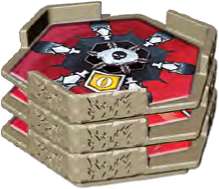
Example: A folded Monolith with the Lords of the Abyss tiles.
Folded Monolith
As long as the Monolith is folded, it is treated as an ordinary Banner. The Banner tile is always in the top segment of the folded Monolith.
Unfolding the Monolith
During his turn, after drawing tiles and discarding at least I of them, the player can decide to unfold the Monolith. If he decides to do so, he cannot place any tiles on the board this turn, though it is still possible to play Order tiles and use the Features of tiles already present on the board.
Exception: If after the Monolith unfolds at least one of the segments is empty, the player can place within it one of the Rune or Champion tiles drawn this turn.
To unfold the Monolith, the player takes out the 2 lower segments from under the Banner. A segment with the Banner does not move/rotate and must remain, unchanged, in the same space.
The remaining two segments can be placed on any empty spaces of the board provided that after unfolding, each of the three segments are connected to at least one other segment, in any configuration. The segments can be freely rotated during placement.
After unfolding, the Monolith remains unfolded until the end of the next Battle, after which it folds back up automatically (more details below).
If the Banner is Netted, the Monolith still can unfold, and fold.
The Monolith cannot be unfolded if, due to lack of free spaces, it is not possible to place the two lower segments on the board.
It is also forbidden to place a segment of the unfolded Monolith on another segment of a Monolith (even empty) and to place an empty Monolith segment under a tile already placed on the board.
Monolith Inseparability Rule
At all points during the game, each of the three segments of the Monolith must be connected to at least one other segment of the Monolith.
In addition, a tile placed within a segment of Monolith cannot be removed by standard rules, only when the tile is destroyed is it removed from the board, and the Monolith.
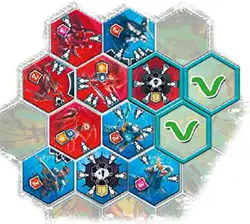
Legal move: The player can unfold the Monolith on the marked spaces.
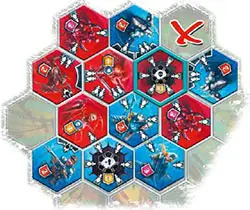
Illegal move: One free space is not enough to unfold the Monolith.
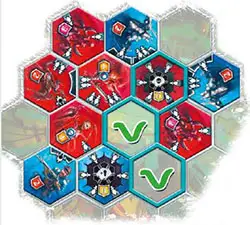
Legal move: The player can unfold the Monolith on the marked spaces.
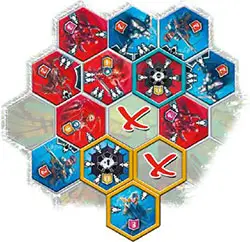
Illegal move: The player cannot unfold the Monolith on a space with another player's Monolith (even if the latter is empty).
Monolith Folding
A Monolith must always fold immediately after Battle. The two segments are folded back under the segment with the Banner which, as during the unfolding of the Monolith, stays unchanged and remains in same space.
You can fold the Monolith even if at least one of the lower segments is empty or contains an enemy tile (more details below). Do not remove any Wound and Poison markers when you fold the Monolith.
The automatic folding of the Monolith as a result of a finished Battle is the only possibility of a Monolith folding back. As opposed to unfolding, a player cannot freely fold his Monolith.
In his turn, the player may again unfold the Monolith which has just automatically folded at the end of Battle using the standard Monolith unfolding rules.
Monolith Rules
A tile placed on a Monolith segment does not receive any additional protection. During Battle, it may happen that the tile located within one of the unfolded Monolith segments is destroyed, leaving an empty segment.
This is treated as an empty board space (for example when checking the automatic Battle condition of the full board), which means that each player can move into, or place a Board tile, on this space.
Folded Monoliths are treated as an ordinary Banner.
Common Problems
A Netted tile cannot be moved, which means that if a Netted tile is in one of the Monolith segments, the Monolith cannot fold after Battle. Remember that a Banner does not move on the board when the Monolith is folding and unfolding, so if it is Netted, the Monolith still can do both.
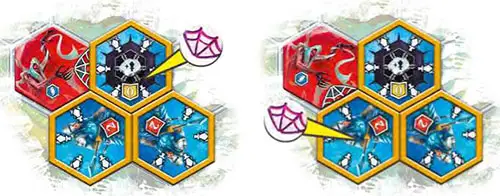
Example: If the Banner is Netted, the Monolith can still fold (see picture to the left).
If a different tile on a Monolith segment is Netted, the Monolith has to remain unfolded (see picture to the right).
Tiles located on the segments of the Monolith always move with them, which means they can be pushed back, moved, etc. as long as the Monolith rule of inseparability is maintained.
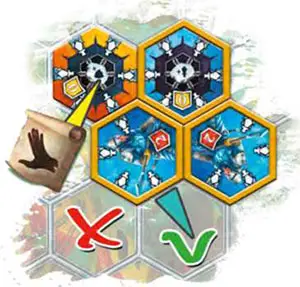
Example: The Guardians of the Realm player has to play the Push Back Order in a way that will not separate the Monolith elements.
A Monolith with an opponent's tile on one of the segments can be folded (and later unfolded). While unfolding, the Monolith owner first decides where to place all of the segments, including the one with the opponent's tile.
Then the player controlling the tile chooses the direction it will be facing. AFTER this is done, the Monolith's owner decides on the facing direction of the tile on the remaining, last segment (as always the Banner stays in the same position).
Note: Unfolding is treated as simultaneous for all three segments. This may prove important for resolving certain special abilities (for example Nets).
Continue Reading
